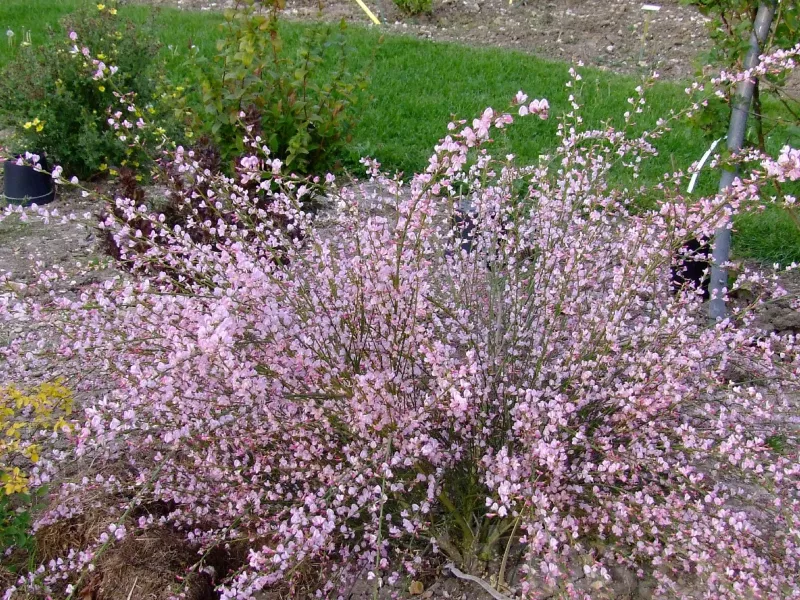Quick Facts
| Flower Type | Cytisus Moyclare Pink |
|---|---|
| Flower Colour | Pink |
| Planting Time | It’s always best to plant plants in Spring or Autumn. However, you can plant from pots year around. Just make very sure that the plant stays moist at all times for at least a month after planting. |
| Watering | Cytisus needs extremely well-drained, preferably acid soil, it hates water-logging and shaded areas. |
| Life Cycle | Semi-Evergreen |
Cytisus Moyclare Pink: 14cm Plant: Please Note: Pre-orders will ship starting End August 2025.
Discover the timeless elegance of Cytisus, a perennial masterpiece that graces the landscape with its majestic presence. Standing tall at 1 - 3 meters. The leaves, a dance of nature, unfold in alternate fashion, adorned with a gentle embrace of hair, trifoliate in form, ranging from 5 - 15 mm in delicate length.
As late summer unveils its golden tapestry, Cytisus takes centre stage, a symphony of blooms that bewitch with their ethereal beauty. Each flower, a testament to nature's artistry, captivates the senses and paints the surroundings in hues of warmth.
Coordination of Logistics for PayFast Orders:
For your convenience, we invite you to stay in direct contact with Marisa through WhatsApp. This will allow you to receive real-time updates on the status of your order and address any specific concerns you may have. You can reach her on the following number: 074 228 2444.
Thank you for choosing Adene Flowers. We look forward to fulfilling your order with the utmost care and attention.
| Flower Type |
Cytisus Moyclare Pink
|
|---|---|
| Flower Colour |
Pink
|
| Flower Size |
Main Stems up to 5cm
|
| Plant Height |
1 meter – 3 meters
|
| Light Preferences |
Full Sun
|
| Plant Spacing |
1.2 meters
|
| Life Cycle |
Semi-Evergreen
|
| Flowering Time |
Late Summer
|
| Pinch |
Prune after flowering to shape the plant and encourage a more compact form. Removing spent flowers can also promote additional blooming.
|
| Planting Time |
It’s always best to plant plants in Spring or Autumn. However, you can plant from pots year around. Just make very sure that the plant stays moist at all times for at least a month after planting.
|
| Planting Depth |
Dig a hole at least two or three times as wide and deep as the root ball.
|
| Watering |
Cytisus needs extremely well-drained, preferably acid soil, it hates water-logging and shaded areas.
|
| Fertilizing |
Use a slow-release granular fertilizer.
|
| Top Tips |
Cytisus, commonly known as broom, is a genus of flowering plants that includes both deciduous and evergreen shrubs. Growing and caring for Cytisus involves providing the right conditions for optimal growth. Here are some top tips for growing and watering Cytisus:
Location: Plant Cytisus in a well-drained soil with a slightly acidic to neutral pH. Good drainage is crucial for preventing waterlogged roots, which can lead to root rot. Sunlight: Cytisus plants thrive in full sunlight. Ensure they receive at least 6-8 hours of direct sunlight per day. Insufficient sunlight may result in reduced flowering and overall poor growth. Watering: Water newly planted Cytisus regularly to establish a strong root system. Once established, Cytisus is relatively drought-tolerant. Water deeply but infrequently, allowing the soil to dry out between waterings. During the growing season (spring to early fall), water when the soil is dry to the touch about 2 inches (5 cm) below the surface. Fertilization: Cytisus typically doesn't require heavy fertilization. Apply a balanced, slow-release fertilizer in the spring before new growth begins. Avoid excessive nitrogen, as it can promote lush foliage at the expense of flowering. Pruning: Prune Cytisus after flowering to maintain a compact shape and encourage bushier growth. Remove dead or weak branches to improve air circulation. Avoid heavy pruning, as Cytisus blooms on previous year's growth. Pests and Diseases: Keep an eye out for pests such as aphids and spider mites. Treat any infestations promptly. Cytisus is generally hardy but can be susceptible to root rot in poorly-drained soils. Winter Care: Some Cytisus varieties are cold-hardy, while others may need protection in colder climates. Mulch around the base of the plant to protect the roots from extreme temperatures. By following these tips, you can help ensure the successful growth and health of your Cytisus plants. Remember that specific care requirements may vary depending on the exact species or variety of Cytisus you are growing, so it's always a good idea to research the specific needs of your particular plant. |
